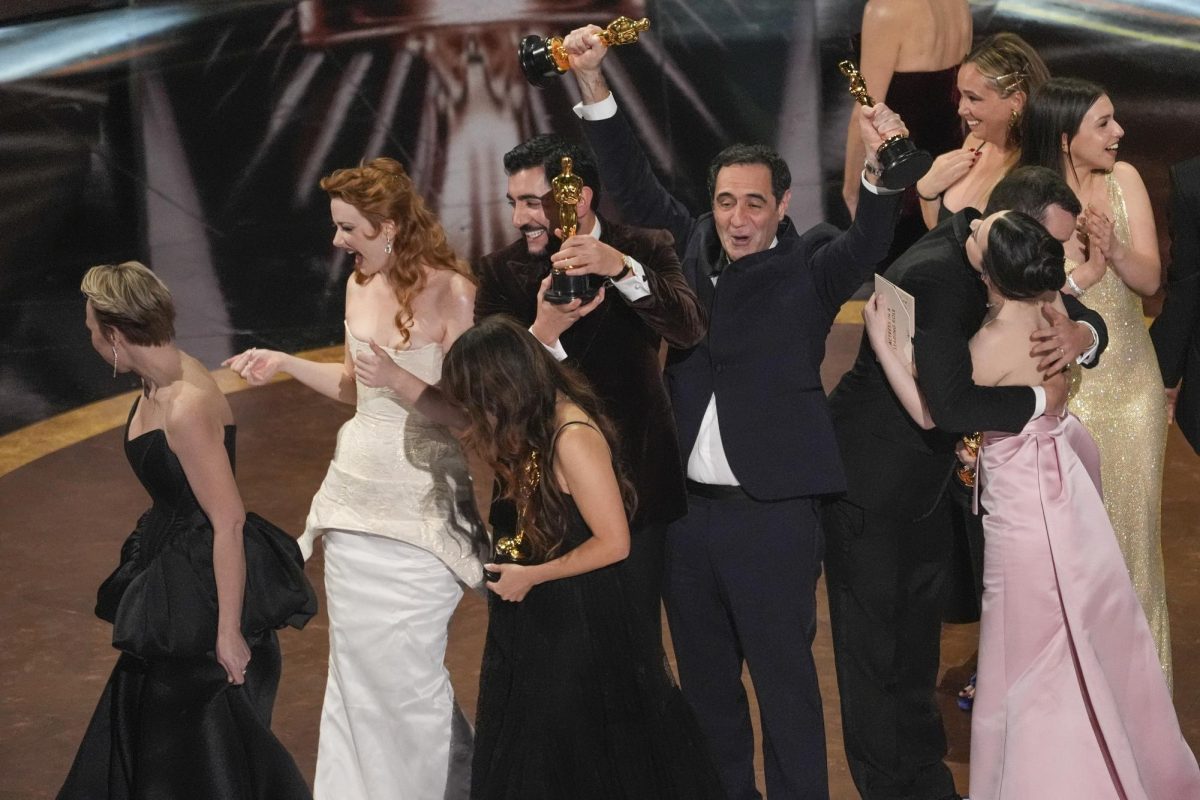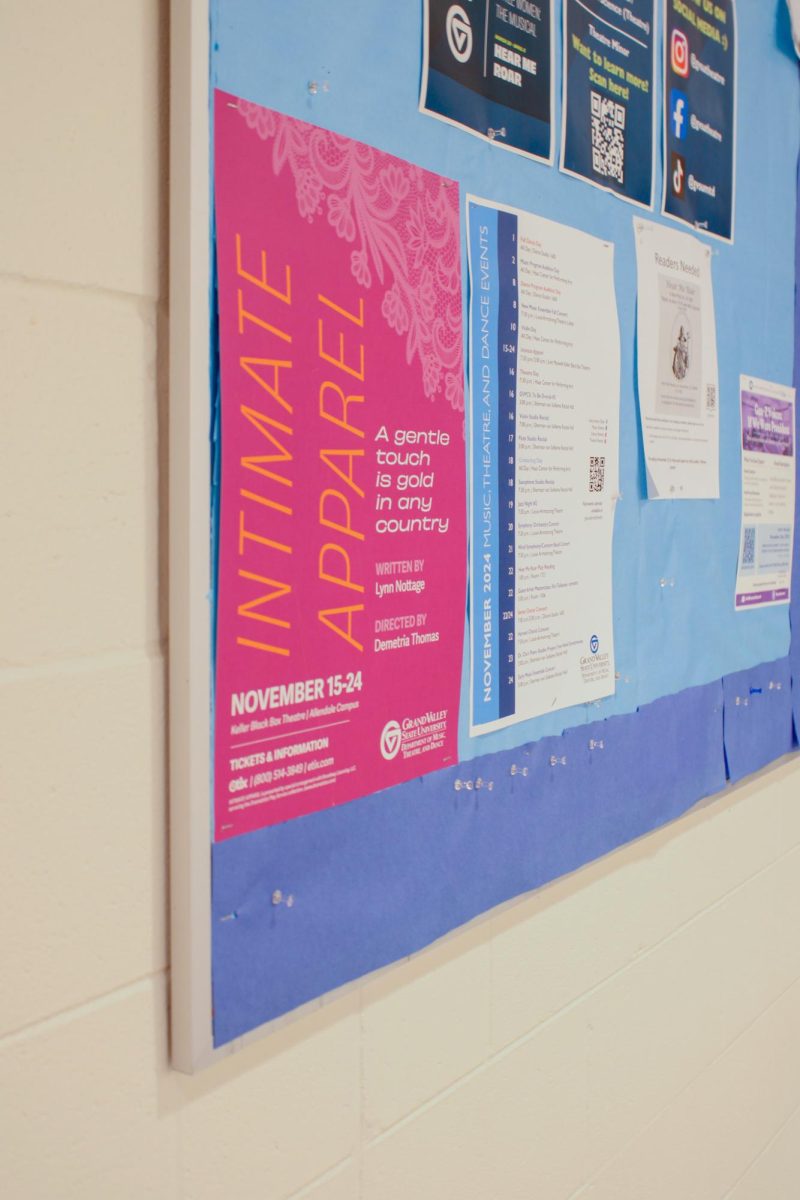Tucked away in the back wing of Grand Valley State University’s Thomas J. and Marcia J. Haas Center for Performing Arts is room 1600: the largest dance studio used by dance program students. Starting at 9 a.m. the studio comes to life as dance students enter the space for the first movement class of the day. They begin stretching, catching up with friends and greet the professor as they enter.
Silently, one more person enters the room: the accompanist. They walk to the back corner of the studio, which contains a piano and drums. They won’t be moving as the dancers do or verbally guide the students like the instructor, instead, the movement will take place as their fingers strike the keys of the piano or beat the drums. The music they play will shape the class at its core.
GVSU’s dance program has two accompanists Alex Hamel and Ryan Blok who create, perform and partner with dance students and faculty within the program’s movement technique classes. Hamel, who has been a part of the program for over 10 years, most commonly accompanies the modern dance courses and Blok has been the resident ballet accompanist since 2017.
The accompanists explore and create music for a collaborative process between movement and music.
When Hamel accompanies modern dance classes he acts as a “one-man band” playing piano and drums individually and simultaneously, a skill that he developed over time and from a young age. Hamel said often he plays both instruments at once because “neither one on its own seemed sufficient.”
Hamel’s playing journey began with learning piano, which his grandfather gave him, at age six. His passion continued to develop with time. He started playing the drums in the school band at age 10 and taught himself guitar at 12.
Continuing to play and learn, Hamel decided initially to minor in music at GVSU and was an art major. At the time he was not planning on pursuing a musical path, but rather graphic design or animation. But, after becoming more involved in music opportunities on campus, he decided to make the shift to becoming a music major.
“I did marching band, stuff like that, to percussion major when I was a student here (GVSU), but I also got into the jazz program. My professors, actually, they were like ‘Seems like you want to be a musician,’” Hamel said. “I didn’t want to study music and not have it be my profession. I think that gave me the confidence to sort of double down on everything I was doing here.”
The decision to fully commit to music led Hamel to accompany the dance program for the first time as a student, a job he had for his last two years at GVSU. With very little knowledge about dance, Hamel took on the role and learned on the job. He learned that the work of the accompanist was largely based on improvisation, which Hamel had experience in as a music major with a jazz emphasis. He soon realized this path fit his passions and has guided the rest of his career.
Now, Hamel primarily accompanies for dance classes and plays in theatre pits. He considers both of these positions “service-oriented, support roles” and feels that is where his heart is.
“I don’t live for the spotlight at all. I actually quit piano lessons because I didn’t want to do recitals anymore,” Hamel said. “In terms of like what I get out of being a musician, it’s really zero to do with like performing or getting my chance to shine or show people what I can do. It’s more being in service to something larger.”
Hamel said the experience of being an accompanist shifts with the needs, wants and energy of the class itself and that the partnership between the music, dancers and professors is deeply intertwined.
“I never think of it like I’m creating music that is to be danced to, like ‘here’s some great music now dance,’ you know,” Hamel said. “In a way, I’m like taking class with all y’all. Just trying to find the impulse within the movement that combination are based on and reflect that and really accompany the dance.”
Dance Professor and dance curriculum coordinator Carrie Brueck Morris has been working with Hamel for over 10 years. She says Hamel’s contribution as a musician and artist allows students to learn more about music in their coursework: musical terminology, how to work with musicians and “understanding the layers” to musicality beyond counts.
Additionally, Morris said Hamel as an artist and partner in dance classes is extraordinary.
“He knows how to look at dance and he knows how to respond to what is happening in the room,” Morris said. “It feels so easy to work with him and I feel like we’re reading each other’s minds.”
Similarly, Blok’s work as the ballet accompaniment comes from years of development. One of Blok’s first musical memories was with a Fisher Price piano where he learned a couple of basic songs. He was then put into piano lessons at eight years old, percussion in band, choir and was involved in church music throughout his life.
Blok, like Hamel, is also a GVSU alum who started at GVSU in 2013 after deciding he wanted to focus more on piano. During this time, he began to learn how to be a ballet accompanist.
“I started with just that a couple books, I had like one piece of music for each combination,” Blok said. “Once I got the feel for the eight-measure phrases all the time and how each combination felt, it just became easier and easier. I’d say a year in I was 90 percent improvising.”
After graduating, he began his accompanist career in the GVSU dance program, played classes at Grand Rapids Ballet and opened a private piano and voice teaching studio.
“My plan was always to somehow make a living in music in Grand Rapids and wasn’t planning on going anywhere,” Blok said.
Blok said the presence of live music helps to shape dance classes in both atmosphere and structure.
“Live music just feels more present. As loud as you turn up a speaker with canned music, it never feels as vibrant in the space as the live music does,” Blok said. “The biggest thing is the flexibility that a live musician can have. Often teachers want to do the same combination, one time at a certain tempo and speed it up for the second.”
Blok values the ability to have a collaborative relationship with the professors and to provide an experience that is “active and vibrant” rather than just a rhythm for students to execute steps to. He enjoys the opportunity and freedom of improvisation and the ability to challenge himself with what he plays each day to better help aid the experiences of dancers in class.
One of GVSU’s ballet professors Carolyn Pampalone Rabbers has worked with Blok since 2021. She feels he not only allows the pedagogical flexibility of changing tempos, measures and more but creates variety within the class.
“(Blok) will find ways to keep it (the music) artistically interesting for the room. So there might be gentle shifts, like an octave change, or an additional rhythmic line added in. It just helps open up possibilities and ideas for ways to engage with the movement that we’re doing as well,” Rabbers said.
Emma Buschle a senior majoring in Dance and Public Relations works with both Hamel and Blok in her modern and ballet courses. Buschle said before coming to college she had never been in a dance class with an accompanist before. She said the experience of having live music in her dance courses at GVSU is incredibly beneficial and rewarding.
From interacting with both musicians, Buschle said Hamel has such a “unique style” in his musical pieces and Blok has a talent for knowing ballet “like the back of his hand.” She feels she has gotten to know the accompanists more as artists and as individuals.
“There’s just a huge level of respect for each other (dancers, professors and musicians),” Buschle said. “At the end of each class, we do a huge round of applause of them and we have a ritual of smacking the floor and creating a bunch of noise to thank them.”
Buschle said over her time at GVSU she has paid more “attention to what’s going on in the corner.” Buschle, and other dance program students and faculty, appreciate the artistry of accompanists. They feel that accompanists connect to everyone in the room at a deeper personal, passionate level than just hitting play.
























